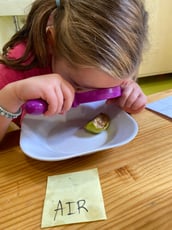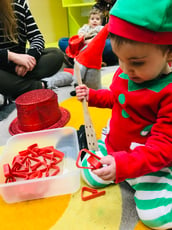Risky Play for a Happy Life
Jill Stribling

It makes every parent and teacher worry, question and doubt as we decide what kinds of limits to set for children. Isn’t risky play a bad thing? On the contrary …. it is an essential type of play for children to engage in for healthy development.
Risk is a situation requiring a choice among courses of action where the outcome is unknown, and yes, could lead to injury. It is through risk and challenge that children learn and grow. This is very different from a hazard, which is something a child does not see and; therefore, does not allow for a choice to be made. When we protect them too much from taking risks in their play we cause harm rather than protect from harm.
Research by Ellen Sandseter, an evolutionary psychologist from Norway, has defined six types of risk taking play that children seek. These are: Great heights (jumping off high places, swinging high, climbing), High speed (swinging, running, twirling, etc), Dangerous tools (ropes, saws, knives, etc), Dangerous elements (fire, cliffs, deep water), Rough-and-tumble play (wrestling, play fighting), and Disappearing/getting lost (exploring alone, playing alone in unfamiliar areas). These types of play benefit a child’s social skills, brain development, learning ability and efficiency, physical development, language development, and emotional development.The benefits of risk taking play are many. Socially children learn how to negotiate, the importance of rules (by creating their own), cooperation, fairness, forgiveness and trust. Spinning, climbing, jumping, and rough-and-tumble play actually develops the part of the higher brain (neocortex) that allows children to maintain attention to a task, develop language, and learn better. Brain development helps them become more creative (creativity is three times more predictive of future success in life than intelligence), curious and better problem solvers.
When children engage in outdoor risky play they are more active than even when participating in organized sports, so they are stronger and healthier. Risky play develops their sensory system, increases balance, coordination, and physical confidence. Risky play actually rarely leads to serious injury. Cuts, bruises and falling are essential parts of body development and awareness. Rough-and-tumble play and other risks help develop not only spoken language skills, but also body language and the language of ones own body. If a friend stops smiling when I am wrestling, I learn that means I may be hurting him and need to stop. If I have “butterflies in my stomach” when I am about to go down a big slide, that means I am challenging myself, but I can do it. If my body is shaking, tense and the “butterflies” feel more like “tigers,” then perhaps this is a challenge I am not ready for and I should stop.
Through taking risks children learn confidence, resilience, how to cope, and how to be good “risk assessors (is this safe, can I do it).” Through risky play children are allowed to practice in a low risk situation (they are engaging in play that they choose and can stop at any time) for the bigger, more challenging risks of life ahead. If they take these manageable risks as a child, they are better equipped to handle and manage the risks they later may have no choice about.
[gallery columns="2" ids="3870,3884,3882,3880,3898,3872,3874,3866"]
In a world that is increasingly fearful about allowing children to take risks and keeps them inside out of fear, research is revealing negative consequences. Children not allowed risky play (including playing on their own without adult supervision) are exhibiting increasingly poor social skills. They do not know how to negotiate, cooperate, understand the value of rules, or trust. It is linked with learning disabilities and poor attention spans. The ability to communicate and “read” the body language of others suffers and increases conflict. Physical health and strength are poorer and there is an increase in children with sensory integration problems. Emotionally there has been a marked increase in child anxiety, depression and inability to cope with and manage stress.
For parents who would like to be more comfortable with and increase their child’s opportunity to engage in risky play, there is a new website to help guide and support you through this process. It was a collaborative project between the University of British Columbia, British Columbia Children’s Hospital, and the British Columbia Injury Research and Prevention Unit. It is designed for children ages 6-12, but the “Journey Map” would be helpful for children of all ages. I recommend looking at the FAQ (Frequently Asked Questions) link first. Check it out. www.outsideplay.ca
Think back ….. what kind of risky play did you engage in as a child? How did you feel while you were doing it?
Jill Stribling
Jill Stribling is the owner and founder of English for Fun, passionately educating with respect for children for 23 years, and a mother of two THRIVING bilingual future adults, Nico and Olivia. She is dedicated and inspired by empowering children and families through FEAR elimination. Jill developed the methodology for English for Fun language academy and began her adventure in mompreneuring in 2008 where 5000+ children have successfully learned to live in English. She proves that with curiosity, confidence, determination, resilience and GRIT, anything is possible! You can find Jill on Linkedin and Instagram at @lifeforfun_es.
Blog posts
Related Articles.

Jill Stribling
Promoting Scientific Inquiry - STEAM learning
Early STEM learning (in the areas of Science, Technology, Engineering and Math) is a very important...

